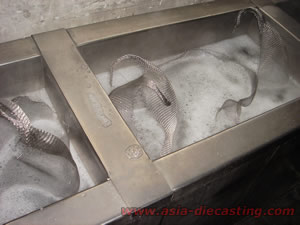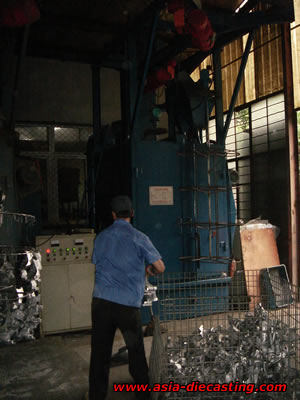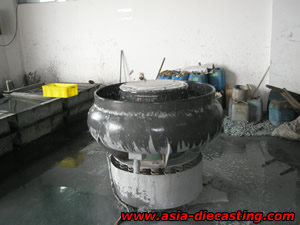Tumbling, sand blasting, ultrasonic cleaning for die casting products
Aluminum and zinc die castings always involve surface cleaning like tumbling ,sand blasting or shooting and ultrasonic cleaning. The key purpose of tumbling and sand blasting is to clean burrs and sand from casting surface, and the ultrasonic cleaning can expose pin holes on the casting surface which is very useful for plating, painting and powder coating.
Parison die casting has special surface cleaning workshop equipped with two tumbling machines, one barrelling blasting machines, one hanging sand blasting machine and three ultrasonic cleaning pools. All of such non-chemical surface cleaning can be done in our own factory.
Sand blasting for aluminum die cast products
Sandblasting or bead blasting is a generic term for the process of smoothing, shaping and cleaning a hard surface by forcing solid particles across that surface at high speeds; the effect is similar to that of using sandpaper, but provides a more even finish with no problems at corners or crannies.
Sand blasting can divided into barrelling blasting and hanging blasting. The barrelling blasting is preferred to small die cast products, while the hanging blasting for large die cast products. Both types of sand blasting can remove oxidized peel from die casting surface effectively.
Tumbling for aluminum and zinc die castings
Metal tumbling or tumble polishing is used for obtaining a specified surface finish, burnishing, burr removal, cleaning, creating radii on edges, deflashing, and breaking runners off of parts in die casting. The process is similar to that explained for rock polishing. The barrel is filled with the parts that are to be barrel. Vanes, typically made of rubber, run along the inside of the barrel. As the barrel turns the vanes catch and lift the parts, which eventually slide down or fall.
Tumbling is an economical finishing process because large batches of parts can be run with little or no supervision by the operator. A full cycle can take anywhere from 6 to 24 hours with the barrel turning at 20 to 38 rpm. In most cases tumbling is most efficient when the barrel is 50% full. Some processes also use a filter system to allow parts or other materials in the cylinder to be separated.
Tumbling can either be a dry, wet, and with or without media. In wet processes a compound, lubricant, or barrelling soap is added to aid the finishing process, prevent rusting, and to clean parts. Media is also used to obtain the desired finished project. Media can have any level of abrasiveness and can be made of a variety of synthetic, metallic, and even organic materials.
Come to other post treatment for die casting
- rapid prototype,die casting and mold design
- CNC machining, precision machining, finishing
- polishing,mirror polishing,brushing
- electroplating: nickel, chrome plating
- powder coating
- e-coating,electrodeposite,electrophoresis
- painting,lacquering,stoving varnish
- chromate passivation, phosphating
- impregnation
- laser cutting, silk screen
- sand blasting, ultrasonic cleaning, tumbling
- assembly and retail packaging
Surface cleaning of die cast products




